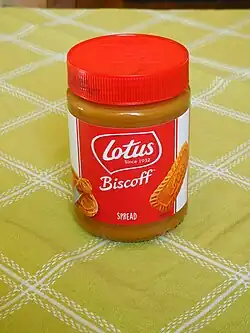Speculoos
 | |
| Type | Biscuit |
|---|---|
| Place of origin | Belgium |
| Main ingredients | Wheat flour, candy syrup, fat, cinnamon |
Speculoos (Dutch: [speːkyˈloːs] ⓘ;[1] French: spéculoos [spekylos]; German: Spekulatius [ʃpekuˈlaːtsi̯ʊs] ⓘ or Karamellgebäck [kaʁaˈmɛlɡəˌbɛk]), known as Speculaas in the Netherlands (Dutch: [speːkyˈlaːs] ⓘ), is a biscuit, with origins in the Low Countries (Belgium and the Netherlands)[2], baked with speculoos spices, which is a mix of cinnamon, and sometimes other spices: nutmeg, clove, ginger, cardamom and pepper, the exact proportions a signature and secret of the bakery who made them.[3] They are usually flat, crisp and moulded to carry certain traditional images. Historically it was popular to eat speculoos around the feast of Saint Nicholas (Dutch: Sinterklaas). The oldest sources on speculoos also mention weddings and fairs. However, it has become normal to eat speculoos all year round, especially with coffee or tea, or with ice cream. Although speculoos stuffed with almond paste (Dutch: gevulde speculaas) and the thicker speculoos chunks (Dutch: speculaasbrokken) remain a specialty of the holiday season in the Low Countries.
Apart from Belgium and the Netherlands, it is also well known in adjacent areas in Luxembourg, northern France, and in the west of Germany (Westphalia and the Rhineland).[4][5] It gained popularity in the former Yugoslav countries, where it is manufactured by the Croatian food company Koestlin. The cookie can also be found in Indonesia and is usually served there at Christmas or on other special occasions.[6] The biscuits have become internationally popular. By the 2020s, in Flanders, the speculoos name is sometimes used in place of the traditional speculaas name.[7]
Etymology
The Dutch name "speculaas" evolved from the older form speculatie (speculation), used to mean "desire" or "pleasure". Originally, speculatie described fine baked goods, appealing to sophisticated tastes. Over time, this term developed dialectal variations like speculacie and speculasie, in which later the ie-suffix was erroneously interpreted as diminutives —eventually resulting in the non-diminutive form we know today as "speculaas".[8][9] In Belgium, a variant called speculoos arose, especially in French-speaking regions. Speculoos, thought to derive from a Brabantian dialect pronunciation, omits the traditional spices in favour of caramelized sugar for flavour. It became internationally popular, especially with the introduction of speculoos cookie butter.
History
Speculoos roots go back to the klaaskoek or "Saint Nicholas cake", a festive treat linked to Saint Nicholas Day on December 6. These early klaaskoeken were among the precursors to what we now recognize as speculoos. Speculoos likely originated in the Low Countries during the Middle Ages, when exotic spices arrived via expanding trade routes. Once a luxury treat, it became associated with Saint Nicholas festivities, often featuring figures of the saint or festive symbols. As the Dutch spice trade grew in the 17th century, speculoos became more accessible.
Lotus Biscoff
In Europe, Lotus Speculoos is the most recognized brand. This manufacturer supplied the biscuits individually packaged to the catering industry. In the United States and the United Kingdom, the same company is branded as Lotus Biscoff, short for "biscuit with coffee". Company founder Jan Boone Sr. created the original recipe in 1932.
In October 2020, Lotus Bakeries decided to omit the word "speculoos" from local markets, to harmonise their products with their Biscoff brand.[10][11] Several chains of supermarkets have started their own product under their generic name. In the US, windmill or almond windmill cookies are mostly based on speculoos.
Spread or paste

Workers in the Low Countries traditionally made a sandwich in the morning with butter and speculoos or speculaas biscuits. This took on a spread-like consistency by lunchtime.[12] In 2008, two competitors entered a contest on the Belgian television show, The Inventors (de Bedenkers), with a spread made from speculoos cookies[12][13] — Els Scheppers, who reached the semi-finals, and the team of chef Danny De Mayer and Dirk De Smet, who were not selected as finalists. Spreads made from crushed Speculoos biscuits went into production by three separate companies and became popular.
By 2007, several Belgian companies began marketing a speculoos paste, now available worldwide under various brands and names: as Speculla, Cookie Butter, and Biscoff Spread. As a form of spreadable speculoos biscuits, the flavour is caramelized and gingerbread-like, with a colour similar to peanut butter[14] and a consistency ranging from creamy to granular or crunchy. The spread consists of 60% crushed speculoos biscuits and vegetable oils.[14][12] In the United States the grocery chain Trader Joe's sells its own brand of cookie butter and cookie butter ice cream.[14]
References
- ^ "Lotus Speculoos - Craving Cups". YouTube. Retrieved 2 July 2024.
- ^ BGDS (2023-12-02). European Christmas Delights - 20 Traditional Christmas Cookies from the Continent's Heart. Gyorgy Bakocs. p. 12. ISBN 978-615-82379-9-4.
- ^ Hoeben, Ronald (2016-11-30). "Speculaaspop bakken". Foodtube. Retrieved 2024-12-11.
- ^ "Spekulatius: a German Christmas classic". www.deutschland.de. 2023-12-06. Retrieved 2024-11-04.
- ^ Larousse gastronomique (in French). Larousse. 2000. ISBN 2-03-560223-8.
- ^ "Resep Kue Zaman Penjajahan Belanda" (in Indonesian). i idntimes. Retrieved 26 May 2020.
- ^ Bob Struijcken (February 3, 2021). "Speculaas vs. speculoos. De verschillen tussen speculaas en speculoos". Koekjes Royale (in Dutch). Retrieved May 23, 2021.
- ^ DBNL. "F. de Tollenaere Hoe is 'speculaas' ontstaan?, Tijdschrift voor Nederlandse Taal- en Letterkunde. Jaargang 101". DBNL (in Dutch). Retrieved 2024-11-05.
- ^ "Speculaas". etymologiebank.nl. Retrieved 2024-11-05.
- ^ "Lotus zegt vaarwel tegen 'speculoos' en kiest voor internationale naam". Het Laatste Nieuws (in Dutch). October 30, 2020.
- ^ Obdeijn, Laura (2020-11-10). "#jesuisspeculoos strijdt tegen de naamsverandering van Speculoos". Het Parool (in Dutch). Retrieved 2021-12-24.
- ^ a b c Castle, Steven (February 15, 2011). "A Cookie Paste Squeezed in the Middle of a Debate". The New York Times.
- ^ "Belgian's popular bread spread not [sic] longer protected". Wolters Kluwer Law and Business. February 2011. Archived from the original on 2015-06-23. Retrieved 2016-04-08.
- ^ a b c "Speculoos Cookie Butter". Trader Joe's. 2012-04-30. Archived from the original on 31 January 2013.
See also
- Cookie butter – Food paste made from speculoos cookie crumb
- Ginger snap – Biscuit with ginger flavor
- Kruidnoten – Dutch sweets
- Springerle – German biscuit
External links
 Media related to Speculoos at Wikimedia Commons
Media related to Speculoos at Wikimedia Commons